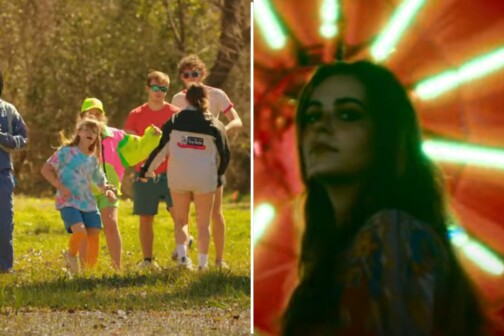We don’t do many live concert reviews, since the concert is over now. But last weekend was a special weekend at the Dallas Symphony Orchestra, likely one of the highlights of our city’s classical music season. And its performances will be available for on-demand streaming for 60 days, starting Feb. 13. A radio version will be broadcast on WRR-FM on March 20.
Midway through a season where the DSO’s attendance has sometimes drooped below pre-pandemic levels, last weekend was a thrilling reminder of just how great the orchestral experience can be—and why we should all be going.
Two stars on the rise visited the DSO. The flashier appearance was by Randall Goosby, a violinist who makes an immediate good impression with his sheer energy. Goosby is a solo performer who radiates enjoyment in his work. When the orchestra played without him, he bounced on his feet, feeling the rhythm. When he duetted with musicians behind him, he half-turned to watch their work. When the music got tough, he grinned as if it was nothing.
And the music did get tough. Tchaikovsky’s Violin Concerto is now considered one of the greats, a piece guaranteed to sell tickets. But when Tchaikovsky wrote it, two solo violinists immediately rejected it as unplayable, and when his third choice accepted, the reviews were harsh: one famed critic said that the violin part “stank to the ear.”
That critic meant that Tchaikovsky’s music was simply ugly, but now I hear a different aroma: the countryside. Many of the hardest parts for the violinist to play are rustic country effects, with a resemblance to folk fiddling technique. Some of these passages come in stamping folk dances. You’d be forgiven for thinking the distance from Russia to Appalacchia is not too far.
Rather than trying to prettify (or city-fy) all that, Goosby leaned into it, embracing all those gritty double-stops with his impeccable technique. He also mastered the other big challenge with Tchaikovsky: repetition. Sorry if this ruins The Nutcracker for you, but Tchaikovsky loves to repeat the same phrase two or even four times in a row. Goosby saw this as opportunity to add a little flair, a little extra sauce, on each new repetition. When his part threatened to spin in circles, he’d build it into a crescendo instead, or point the rhythm more sharply each time, turning stasis into momentum.
In other words: this guy’s the real deal. He looks like an eager young artist—the violin’s chin rest was a mere suggestion as Goosby’s head swung and swiveled with the beat—but he thinks like a serious musician about how to make the music better. With his encore, he offered the Dallas audience a rare treat: the Louisiana Blues Strut by Coleridge-Taylor Perkinson, a Black composer and conductor who co-founded America’s first integrated orchestra and arranged songs for Marvin Gaye.
Goosby is a future superstar. The talent next to him on the conductor’s podium was a former Dallasite who is also ticketed for stardom: Karina Canellakis, the orchestra’s ex-assistant conductor. She now has a thriving career in Europe leading an ensemble in The Netherlands and makes frequent guest appearances in Berlin and London.
On either side of Goosby’s solo Tchaikovsky turn, Canellakis led the orchestra in bold, loud, colorful performances of bold, loud, colorful music by Dvorak and Lutoslawski. Forgive my editorializing: music like this is why we go to the symphony. We want our ears to be pinned back. We want the music to conjure vivid images in our heads. We want to watch the timpanist thwack the drums with both hands, to watch the clarinetist swap instruments on a whole hat rack of clarinets, to see melodies as they whip across the orchestra from section to section, to crane our necks when we hear instruments offstage, to watch percussionists race from one instrument to another.
Lutoslawski’s Concerto for Orchestra begins with a tremendous, rib-rattling bass drum thwack, which caused the person next to me to whisper, “Now that’s a good start!” It ends with one, too. In between, all kinds of mayhem takes place: pounding rhythms, creepy xylophones, brass instruments blaring like sirens, trance-like repetitions, raucous outbursts. The piece is simply laid out and easy to follow in structure, and although it doesn’t have singable melodies, it does have catchy hooks, weird little ideas that will get stuck in your head. But the reason that it’s so unforgettable is that, purely as a listening experience, it’s Mad Max-level bonkers. It demands to be seen live and loud.
Canellakis let the orchestra slow down and exhale exactly twice in the concerto’s half-hour length, at the two moments when Lutoslawski gets close to allowing a bit of human emotional warmth in. Otherwise, it was a pure, delicious frenzy of manic solos for everybody, from the double basses to the two piccolos. There are so many solos that at the end, when the crowd burst into applause, Canellakis had more or less every member of the DSO stand by themselves to take a bow.
This is the kind of concert orchestras were made for. Canellakis got detailed, sharp playing and clear balances out of the DSO players, but she also embraced the bigness and sheer fun of the orchestral experience. When you get 100 musicians on a stage together, you have to go big or go home. Subtleties are nice, and poetry is appreciated, but an orchestra at its best provides immersive sensory thrills.
That’s a relief after my last DSO experience, when “poetic” pianist Paul Lewis sleepwalked through Grieg’s Piano Concerto. That’s also why, after a few autumn nights at the DSO where I felt like the only person in the balcony, it was nice to see a full concert hall treated to Goosby’s talent and the DSO’s virtuosity. I was starting to worry about attendance. But this weekend, Dallas turned out. And this weekend, the orchestra brought the thrills.
P.S. If your taste in live classical concerts is like mine—“make big orchestra go boom”—mark your calendar for next week’s appearances by jazz trumpeter and composer Terence Blanchard in a small group and highlights from his opera Fire Shut up in My Bones. And don’t miss the Feb. 23-25 weekend’s tale of two Gabrielas: Mexican composer Gabriela Ortiz and Venezuelan pianist Gabriela Montero, who will play a Latin-inspired concerto she wrote herself.
And if you’re really a metalhead, book tickets for April 27-30, when the orchestra performs Shostakovich’s Fourth Symphony, an hour-long no-intermission bombardment involving the biggest ensemble of any piece the DSO will employ this year.
Author







